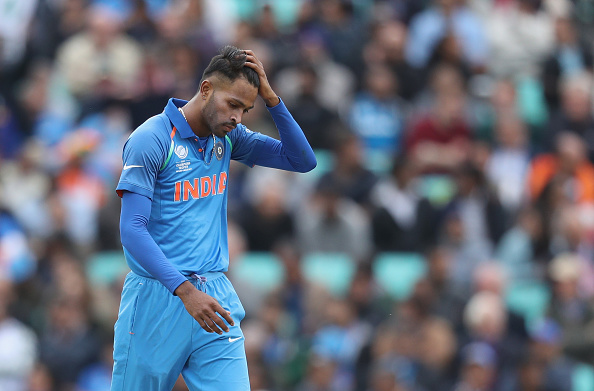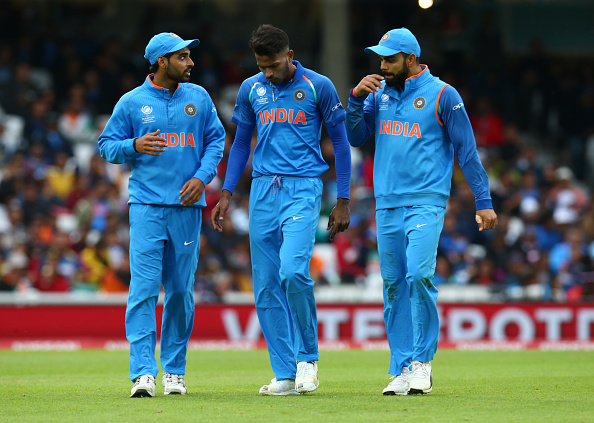
Champions Trophy 2017: Is Hardik Pandya a batting all-rounder or a bowling all-rounder?
Since the emergence of Ravindra Jadeja, typically Indian Limited Over teams have consisted of 5 batsmen, 1 wicketkeeper, and 5 bowlers (2 spinners + 3 seamers). However, with Hardik Pandya‘s rise to prominence, the balance of the playing 11 has been shifted. Hardik initially played as a number 7 batsmen and 3rd seamer. However in the 2017 ICC Champions Trophy, he has been picked as the 4th seamer, and India have chosen to sacrifice the 2nd spinner.
India have always been obsessed with a fast bowling all-rounder. In the last 15 – 20 years they’ve had Irfan Pathan, Joginder Sharma and Stuart Binny, none of who have managed to make the position their own. Pathan showed a lot of promise but his bowling has gone downhill over the years, with both pace and swing now longer prominent.
Pandya first emerged on the scene in the 2015 IPL. He established himself as the big hitting, fast bowling all-rounder. In the 2015 IPL, he played 9 games, scored 112 runs at an average of 22, however what stands out is his excellent strike rate of 180. However, in the 9 games he just took 1 wicket at an economy of 10 runs per over and bowled an average of just 11 balls per game (1.5 overs)
Extra cover: Champions Trophy 2017: Hardik Pandya's bowling a cause of concern for India
He then went on to play his first season of International Cricket for India in the T20 games in Australia, followed by the Asia Cup and the T20 World Cup. In 16 T20 games in 2016, he scored 78 runs at an average of 11 at a strike rate of 140. He picked up 15 wickets at an economy of 8 runs per over while bowling an average of 16 balls (2.4 overs) per game. During that period, he played as India 5th bowler but struggled to finish his quota of 4 overs per game.
In ODI cricket, Pandya made his debut towards the end of the 2016 season. So far, he has played 9 games scoring 189 runs with an impressive average of 47 at an excellent strike rate of 130. He has shown great improvement with the bat, and has shown signs of being able to not only hit the big shots in the end but also construct innings and finish games for India.
In these 9 games, he has picked up 11 wickets at an economy of 5.9 runs an over, bowling an average of 44 balls per game (7.2 overs).However, in these 9 games he has finished his quota of 10 overs just once. And in 19 T20 games for India overall, he has bowled his quota of 4 overs just 4 times.
Even in his successful 2017 IPL campaign where he did very well with the bat scoring 250 runs at an average of 35 and strike rate of 156, he bowled an average of just 9 balls per game (1.3 overs), taking 6 wickets at an economy of 8.19.
There is a general belief that an all-rounder must be able to hold his place in a side as a batsman or as a bowler. The likes of Andrew Flintoff, Ben Stokes, Jacques Kallis, Shaun Pollock, Lance Klusener and even Sanath Jayasuriya were/are world class all-rounders who had a core skill and supplemented it with their secondary skill. With Pandya, we are not yet quite sure whether he is a batting all-rounder or a bowling all-rounder.
Pandya has great potential and could eventually develop into a great all-rounder for India. However, his presence in the squad currently is affecting the overall balance of the squad. India currently doesn’t have a quality 6th bowler that they had in the form of Suresh Raina or a younger Yuvraj Singh.
Yuvraj has bowled just 5 overs since his return to ODI cricket in 2017 and hasn’t picked up any wickets. Kedhar Jadhav has been used as the 6th bowler off late, however, all his wickets have come playing in India. He hasn’t been tested on tracks that don’t support spinners.
The current Indian bowling lineup is expected to bowl their quota of 10 overs each, however, with Hardik being unable to bowl his quota, and if another frontline bowler goes for runs, then there is tremendous pressure on Kohli to use his part time bowlers (who are also currently under par) to step in. The game against Sri Lanka was a great example of the front line bowlers not being able to stop the flow of runs as a result of which Sri Lanka managed to chase down the target fairly easily.
India need to re-assess their balance for the future games. If they believe that Pandya can be a good lower order batsmen and can chip in with the ball, then they should pick him at no 6, instead of Kedar Jadhav, and go in with 5 frontline bowlers (2 spinners and 3 seamers).


